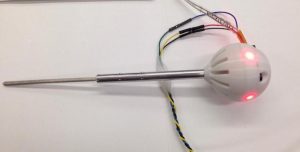Johns Hopkins University

 2014 BMEStart Second place winner, winning $5,000
2014 BMEStart Second place winner, winning $5,000
The AccuSpine team has developed a probe to assist in correct placement of screws during spinal surgery. Of the approximately 500,000 spinal fusion surgeries performed annually in the United States, over 20% of screws are misplaced. This leads to postoperative neurological or vascular complications, which necessitate reoperations in 1 to 5% of patients, costing the American healthcare system over $500 million annually. In the established paradigm, a pedicle probe is inserted manually into the vertebra to create a pilot hole, a trajectory that the screw follows. It is difficult to achieve a stable or even safe trajectory with the limited physical feedback from the probe, so this technique is most often performed under fluoroscopic guidance. To enable spine surgeons to more accurately place pedicle screws and reduce associated breaches in spinal fusion procedures, this team has designed and prototyped AccuSpine, an improved pedicle probe to replace the current “ball-and-stick” model probe. AccuSpine is able to provide feedback regarding its location within the pedicle and alert the surgeon of an impending cortical wall breach with both vibrational and visual feedback. The device consists of a spherical handle incorporating three resistive force transducers to measure forces in multiple axes. When the surgeon pushes the probe from soft to hard bone, a sudden force spike will occur, signifying a breach. The handle also houses the feedback system obtained using a button vibrational motor and four red LED lights that flash, respectively, when a breach is detected. AccuSpine’s feature set enables projected reductions in operating time by 15% with projected cost savings of 10% per surgery, an average of $9,000 per procedure.